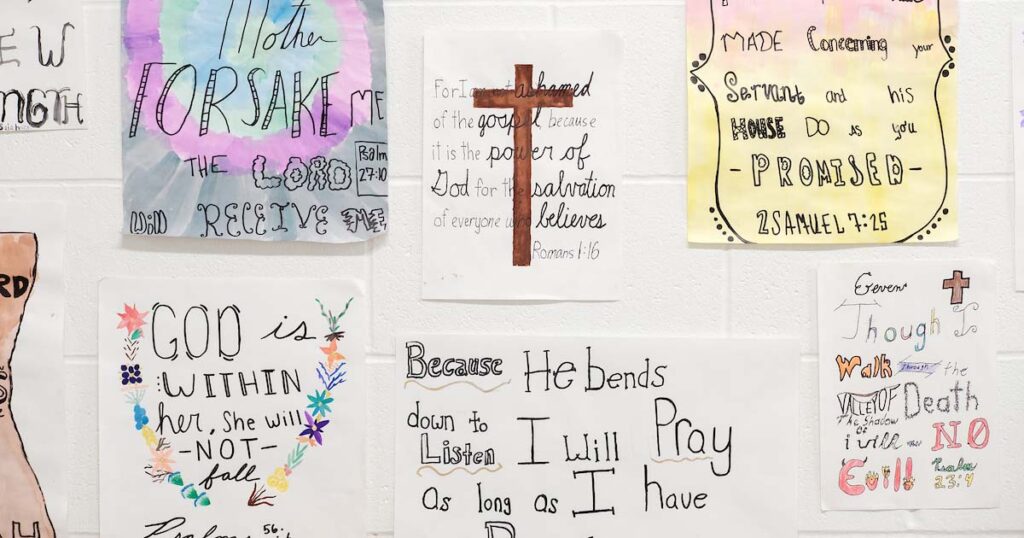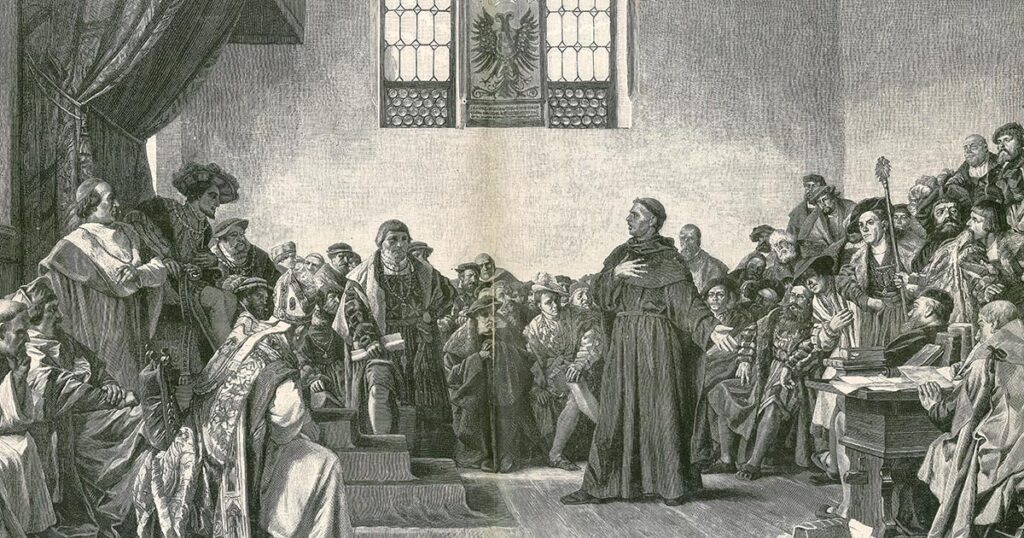God built countless gifts into His creation. He gave us the warmth of fire, the smell of dirt and the taste of apples gathered in a sunny orchard in October. He also gave us poetry. Poems may not grow on trees, but they still occur as part of the created order. Humans instinctively desire to shape words into songs and verses. What a gift that God created both language and beauty and gave humans the ability to delight in them.
Poetry teaches us. Christians are people of words. Scripture involves an abundance of complex phrases, meaningful vocabulary choices and beautiful language. Our ability to understand and enjoy the Bible grows when we increase the dexterity with which we process words. Poetry and other literature move us beyond a flat, technical, dictionary approach and lets us enjoy the many nuances, implications, sounds, feelings and glories of language.
Poetry shows us how to think in ordered ways. Modern American culture defines the human experience through the misleading lens of our own undisciplined feelings and desires. The historic tradition of great poetry highlights a better way. It avoids materialism by recognizing spiritual, emotional, moral and aesthetic truth; it also nudges us back from chaos of this life by embracing structure and order as tools we need to express reality.
Best of all, great poems are memorable. Long-remembered lines can encourage us in hard times. They can give us the ability to put our own inner experiences into words. Lutheran hymnists have long recognized the power of poetry to communicate and teach, and our hymnals are packed with poems in a wide variety of styles. If we and our children abandon the long tradition of great poetry, what will happen to the future of Lutheran hymn writing?
Once a central part of Western education, poetry has fallen on hard times. Popular culture relegates it to the domain of sappy greeting card writers and egg-headed academics. Gone are the days when adventurers like Sir Walter Raleigh lamented their imminent execution in powerful verse, or school boys routinely thrilled to “Horatius at the Bridge!” Few families can spend an entire afternoon competing to see who can recite the most “pieces,” as Laura Ingalls and her sisters did. Yet beautiful verse is far too good to waste on sappy greeting cards. It is time for us to take poetry back! We can share it with our children and make it part of our lifestyle.
How do we make beautiful poetry part of our family life?
The first step is to shift expectations. Poetry is a normal part of the good life, and properly guided children will enjoy it. Read poetry in front of your children. Share beautiful and stirring verses with your kids as eagerly as you carry in the cake on their birthday or point out a baby elephant at the zoo. Stick to small doses at first. It is better to read one short poem twice than to read three different poems. Let the poems themselves do the teaching and talking. Direct your energy to relishing the glorious language right along with your kids.
Do not neglect nursery rhymes. Bizarre as some of them may sound to modern ears, they form part of our cultural heritage for a reason. They provide children with a word playground. They are intended to be physical. They provide a “beat” for bouncing on daddy’s knee, walking up the stairs, jumping rope or handwashing. Nursery rhymes are an experience in the natural rhythm of language, and children who have internalized these patterns by chanting “pease porridge hot, pease porridge cold,” are better able to enjoy metric poetry as they get older.
Seek out picture books that combine the words of a classic poem or ballad with charming illustrations. Enjoying poetry though picture books aligns well with the small child’s natural desire to read the same story over and over. Before long, you and your little ones will find yourselves reciting Stevenson or Lear. Older children also enjoy a well-illustrated volume of poetry, even if you need to trick them into reading it by providing them with a younger friend or relation to read aloud to. Once your kids are old enough, try taking a novel-length piece of poetry, such as G.K. Chesterton’s “Ballad of the White Horse,” and staging a dramatic reading session with several families.
Over time you will want to explore poetry more deeply. Pick a single poet or hymn writer and get to know him alongside your children. Learn about his historical context, and then read a few of his poems every week. You will gain a deeper sense of who this poet was and what he was trying to communicate. Eventually, you may be able to recognize his work from its style.
As you read more difficult works, repetition and memorization are your friends. Take the advice of Ken Ludwig, author of How to Teach Your Children Shakespeare. He argues that “the way to introduce someone to Shakespeare for the first time so that it doesn’t feel daunting and yet has real integrity” is “to memorize it.” I think the principle applies to difficult poetry in general. Children who can understand and recite a phrase like, “I know a bank where the wild thyme blows, where oxlips and the nodding violet grows,” have received a gift. They are able to slow down and process language at leisure while they play or rest.
Poetry’s power lies in a paradox. On the one hand, the creation of poetry is simply the expression of the impulse toward language and beauty that comes naturally to all of us. On the other, great and enduring poems are an incredibly difficult feat — something we should celebrate. I heartily encourage you to make versified literature part of your own family culture. Raise children who will wander into the kitchen and shout, “‘Come in! come in, my prince!’ said she, / And opened wide the gate; / ‘To die with Prince Charlie Stuart, / I ask no better fate!’” (see “Moy Castle” in The Golden Books Family Treasury of Poetry). Raise children who love the gift of language.
To help you get started, here is a list of resources my family loves. Those that are out of print may be available in your local library.
Resources
Board Books for Little Ones
- The Swing by Robert Louis Stevenson, illustrated by Julie Morstad
- The Owl and the Pussycat by Edward Lear, illustrated by Jan Brett
- Board books from Kloria Press
- The Real Mother Goose and My First Real Mother Goose, illustrated by Blanche Fisher Wright
- Other assorted Mother Goose books (depending on your style, try editions illustrated by Richard Scarry, Marguerite De Angeli, Rosemary Wells, Tomie De DePaola or Salley Mavor)
Books for Preschool and Early Elementary
- Where Go the Boats? by Robert Louis Stevenson, illustrated by Chris Sheban
- Color by Christina Rossetti, illustrated by Laetitia Devernay
- Wynken, Blynken, and Nod by Eugene W. Field, illustrated by David McPhail
- My Shadow by Robert Louis Stevenson, illustrated by Penny Dale
- Over in the Meadow by John Langstaff, illustrated by Feodor Rojankovsky
- The Fox Went Out on a Chilly Night, illustrated by Peter Spier
- Over the Hills & Far Away, illustrated by Chris Conover
- Stopping by Woods on a Snowy Evening by Robert Frost, illustrated by Susan Jeffers
- God’s Own Child, I Gladly Say It, illustrated by Jonathan Mayer
Books for Older Kids
- Paul Revere’s Ride by Henry Wadsworth Longfellow, illustrated by Ted Rand
- The Star-Spangled Banner by Peter Spier
- The Tale of Custard the Dragon by Ogden Nash, illustrated by Lynn Munsinger
- If by Rudyard Kipling, illustrated by Giovanni Manna
- Casey at the Bat by Ernest Lawrence Thayer, illustrated by Gerald Fitzgerald
- The Charge of the Light Brigade by Tennyson, illustrated by Alice and Martin Provensen
- The Village Blacksmith by Henry Wadsworth Longfellow, illustrated by G. Brian Karas
- The Deacon’s Masterpiece: Or the Wonderful One-Hoss Shay by Oliver Wendell Holmes, illustrated by Paul Galdone
Poetry Collections for the Whole Family
- A Child’s Garden of Verses by Robert Louis Stevenson, illustrated by Tasha Tudor (or the one illustrated by Gyo Fujikawa)
- A Child’s Garden of Verses: A Pop-up Book by Robert Louis Stevenson, illustrated by Jannat Messenger
- Enjoy the Poems of Emily Dickinson, selected by Ruth Smith
- The Golden Books Family Treasury of Poetry, selected by Louis Untermeyer, illustrated by Joan Walsh Anglund
- The Harp and Laurel Wreath, selected by Laura M. Berquist
- Lutheran Service Book from Concordia Publishing House
Additional Resources for Adults
- Rules for the Dance: A Handbook for Writing and Reading Metrical Verse by Mary Oliver
- How to Teach Your Children Shakespeare by Ken Ludwig
- The Soul in Paraphrase: A Treasury of Classic Devotional Poems, selected by Leland Ryken
- The Best Loved Poems of the American People, selected by Hazel Felleman
Photo: LCMS Communications/Erik M. Lunsford




Again– thank you for these wonderful suggestions.